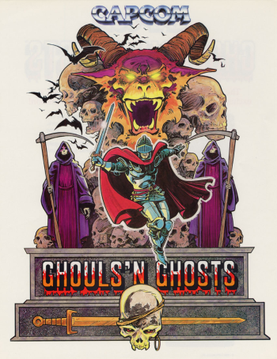
Ghouls 'n Ghosts, known as Dai Makaimura in Japan, is a side-scrolling platform game developed by Capcom, released as an arcade video game in 1988 and ported to home platforms. It is the sequel to Ghosts 'n Goblins and the second game in the Ghosts 'n Goblins series.
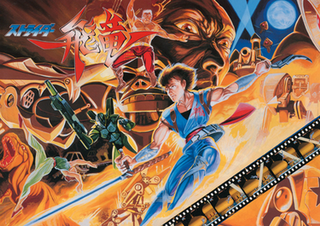
Strider, released in Japan as Strider Hiryū, is a hack-and-slash platform game released in arcades in 1989 by Capcom. Set in a dystopian future where Earth is ruled by the tyrannical Grandmaster Meio, it follows the titular Strider named Hiryu as he attempts to end his tyrannical reign for good. The game resulted from cooperation between Capcom and manga publisher Moto Kikaku. It marked the video game debut of Strider Hiryu, after the character was introduced in the 1988 manga Strider Hiryu.

X-Men: Children of the Atom is an arcade game that was produced by Capcom and released on the CP System II arcade hardware in 1994 in Japan and in 1995 in North America and Europe.

19XX: The War Against Destiny is a vertical scrolling shooter arcade game released by Capcom in 1995. The story takes place before a fictional 20th century war as a lone pilot tries to defeat an entire army and evil organization from starting another World War, which soon escalates to a nuclear apocalypse.

U.N. Squadron is a 1989 side-scrolling shooting game released by Capcom for the CPS arcade hardware and for the Super Nintendo Entertainment System. The game was released in Japan as Area 88, and is based on the manga series of the same name, featuring the same main characters. Their mission is to stop a terrorist group known as Project 4. It was followed by a spiritual successor Carrier Air Wing.

Cadillacs and Dinosaurs, released in Japan as Cadillacs Kyouryuu Shinseiki, is a 1993 arcade game by Capcom. It is a side-scrolling beat 'em up based on the comic book series Xenozoic Tales. The game was produced as a tie-in to the short-lived Cadillacs and Dinosaurs animated series which was aired during the same year the game was released. A version for the Capcom Power System Changer was planned and previewed but never released.
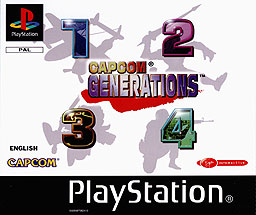
Capcom Generations is a series of five video game compilations produced by Capcom for PlayStation and Sega Saturn. Each volume contains three or four games from a particular series or game genre and were ported directly from their original arcade versions. Each disc also contains a "collection mode" featuring history, tips, artwork, character profiles, arranged music and other unlockable contents for each game. The PlayStation versions of the games also featured support for the DualShock controller.

R-Type Leo is a 1992 horizontal-scrolling shooter arcade game developed by Nanao and published by Irem. It is a spin-off of the R-Type series and the last R-Type entry to be released in arcades. In Leo, players take control of the titular space fighter to travel the man-made mechanical planet Eden and destroy its supercomputer core Major. The game was initially conceived as an original shoot 'em up by Nanao before being retooled into an R-Type project by Irem. The title was met with positive reception from reviewers. It has since been re-released as part of Dotemu's 2010 Irem Arcade Hits compilation.

Forgotten Worlds, titled Lost Worlds in Japan, is a side-scrolling shooter video game by Capcom, originally released as a coin-operated arcade game in 1988. It is notable for being the first title released by Capcom for their CP System arcade game hardware.
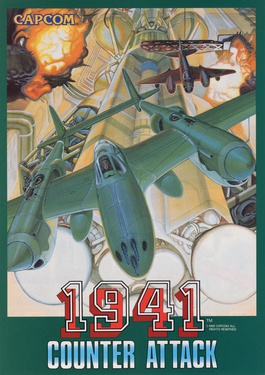
1941: Counter Attack is a vertical scrolling shooter arcade game by Capcom, released in February 1990. It is the prequel to 1942, and the third game in the 19XX series. It was ported to the SuperGrafx in 1991 and to GameTap. It was released on Capcom Classics Collection Remixed for the PlayStation Portable and Capcom Classics Collection Vol. 2 for PlayStation 2 and Xbox. It was followed by 19XX: The War Against Destiny in 1996.
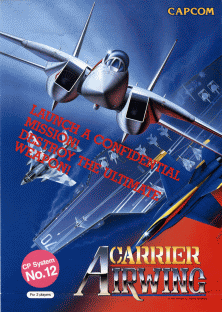
Carrier Air Wing, released in Japan as U.S. Navy, is a 1990 side-scrolling shooting game released for the CP System arcade hardware by Capcom. It is the spiritual successor to U.N. Squadron, which was released in the previous year. As with the original, players chose any one of three different jet fighters and battle their way through ten enemy-packed stages. Other ideas carried over from U.N. Squadron include the shop, which allows players to buy weapon and shield upgrades for their jet fighter between stages, and the energy bar, which is replaced by a "fuel bar" which starts full at the start of each stage and decreases as time passes with some fuel lost each time the plane is damaged. The game has two different endings, depending on whether the game is finished with only one coin or not. A version for the Capcom Power System Changer was planned and previewed but never released.
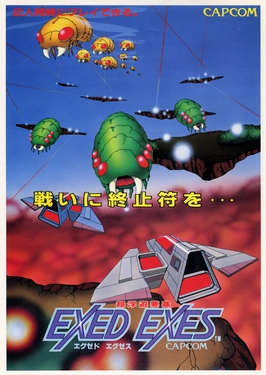
Exed Exes is a vertically scrolling shooter video game that was released in arcades in 1985 by Capcom.

The Punisher is a 1993 beat 'em up arcade game developed and released by Capcom. It stars the Marvel Comics' antihero the Punisher and co-stars S.H.I.E.L.D. agent Nick Fury as the second player's character as they embark on a mission to kill the crime lord the Kingpin and bring down his organization. While following the same general formula as Capcom's previous beat 'em ups, the game has a range of usable weapons and a comics-style presentation.

Pulstar is a horizontally scrolling shooter released for arcades by SNK in 1995. Players control a starship in its mission to eradicate the Solar System of a hostile race of aliens that threaten mankind. Its gameplay has been compared to the R-Type series for its similar premise and mechanics; players must complete each of the game's eight stages by destroying constantly-moving formations of enemies and avoiding their projectiles. There are power-ups that can be collected that provide additional abilities for the player. It runs on the Neo Geo MVS arcade system board.

Darkstalkers: The Night Warriors, known in Japan as Vampire: The Night Warriors, is the first title in the Darkstalkers fighting game series, developed and released by Capcom in 1994, originally for the CPS II arcade hardware. It was ported to the PlayStation by Psygnosis in 1996 and was followed by Night Warriors: Darkstalkers' Revenge in 1995. Darkstalkers: The Night Warriors was ported as a part of Capcom Fighting Collection on June 24, 2022 to Nintendo Switch, PlayStation 4, Windows, and Xbox One.

Three Wonders is a 1991 video game collection developed and published by Capcom, originally released for the arcades using the CPS-1 platform. It includes three related titles: Midnight Wanderers: Quest for the Chariot, a platformer; Chariot: Adventure through the Sky, a scrolling shooter; and Don't Pull, a puzzle video game.
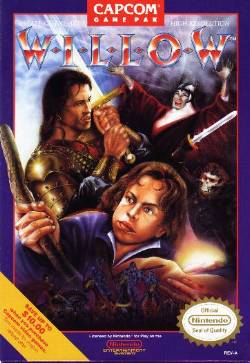
Willow is a 1989 2D action role-playing game developed and published by Capcom for the Nintendo Entertainment System. It is loosely based on the 1988 film of the same name and is the second title Capcom released based on Willow that year, the first being an unrelated side scrolling arcade game. The version of Willow released for the Nintendo Entertainment System and the Famicom is an adventure game in the vein of The Legend of Zelda.
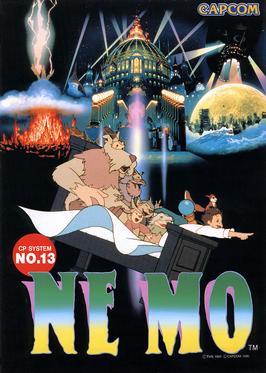
Nemo is a side-scrolling fantasy arcade game released by Capcom in 1990. The game is based on the anime film Little Nemo: Adventures in Slumberland.

Prehistoric Isle is a 1989 scrolling shooter arcade video game originally developed and published by SNK. Set during the 1930s, where ships at The Bahamas mysteriously disappeared, players assume the role of U.S. Marine pilots taking control of biplanes in a reconnaissance assignment at "Greenhell Isle", a fictional island inhabited by dinosaurs and creatures thought to be extinct. Headed by a director under the pseudonym of "Yah!", the game was developed by most of the same team that would later work on several projects for the Neo Geo platforms at SNK. Although first launched in arcades, the title has since been re-released through download services and compilations for various consoles. It received positive reception since its initial arcade release from critics who praised the visuals, sound design, gameplay and originality. A sequel, Prehistoric Isle 2, was released in 1999 for the Neo Geo MVS but garnered less success than its predecessor.

Super Spacefortress Macross is a 1992 vertically scrolling shooter arcade video game developed NMK and published by Banpresto. Based upon the 1984 anime film Macross: Do You Remember Love?, it is the first arcade entry in the Macross franchise. In the game, the players control the VF-1 Valkyrie variable mecha fighters, piloted by Hikaru Ichijyo and Max Jenius, in a battle against the Zentradi alien race.





















